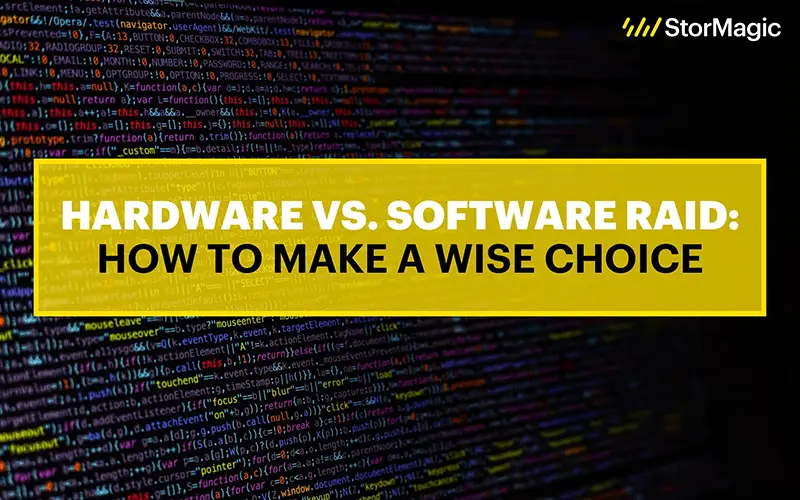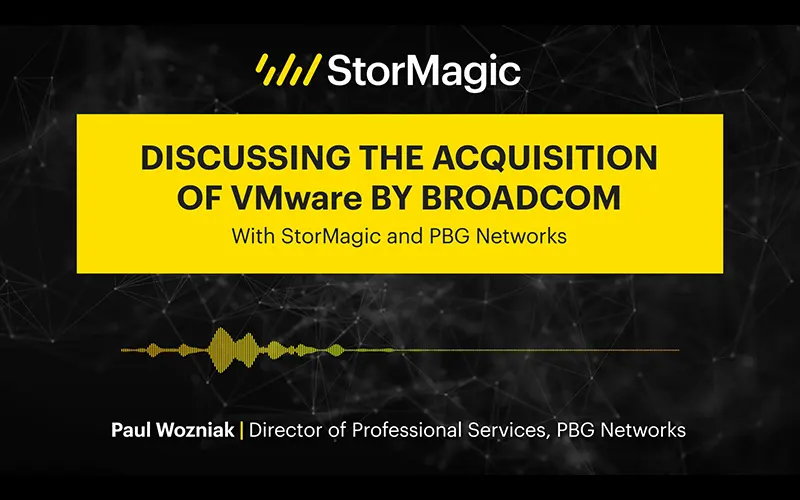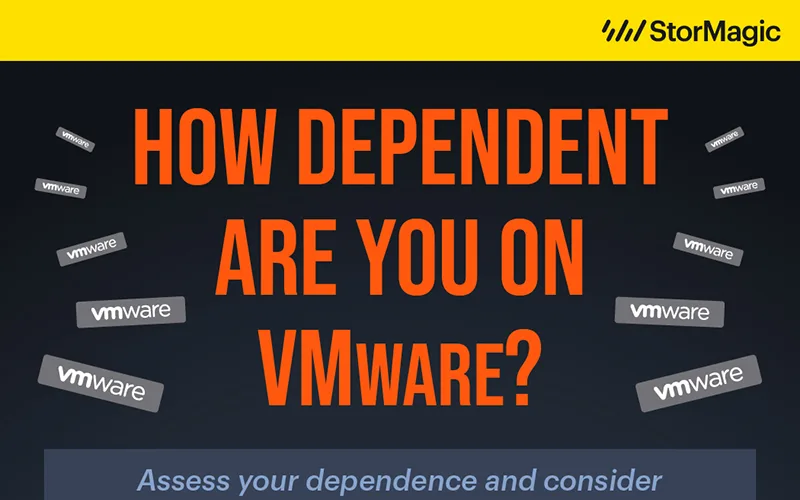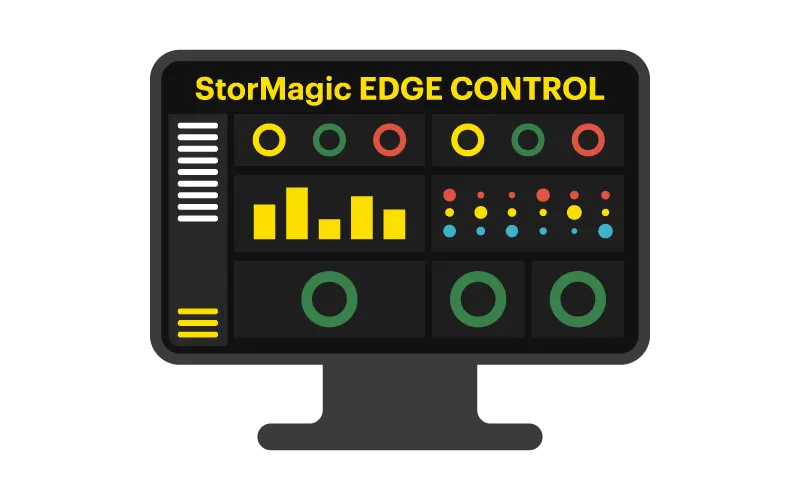The need for RAID at the edge
RAID (redundant array of independent disks) is just one critically important form of data protection and has been a key component in disk drive configurations since the 1980s. It enables users to easily distribute data from any application across multiple physical storage devices, so that if one device fails, the applications keep running while the failed one is replaced.
For edge computing, RAID is a particularly useful tool. As edge sites are commonly based far away from the tight security and onsite IT team of the datacenter, they’re at an increased risk of data loss from hardware failure. Distributing critical data across multiple storage devices offers a commonly-understood and practical means of basic data protection.
Furthermore, there is an ever-expanding set of workloads that are being backed up to a datacenter or cloud, but this comes with its own set of challenges. As a general guide, moving 10 TBs of data in a 24-hour period requires a 10 Gbps network link. Such large network links may not be feasible, depending on the amount of new data being generated per day. Even if backing up to a datacenter or cloud is required by the business, it’s important to ensure that data is first protected locally, and RAID is the cornerstone of fault-tolerant storage for the general-purpose server market.
Organizations wishing to protect their data at the edge must look beyond RAID and see it as just one component of a wider data protection strategy. But even with RAID, there are numerous options that organizations must consider. RAID is available as a virtual, software or hardware solution and each of the three types brings advantages in certain circumstances. Below, we discuss which is best suited to edge environments, but first, let’s explore each type of RAID in turn.
Virtual vs hardware vs software RAID
Virtual RAID
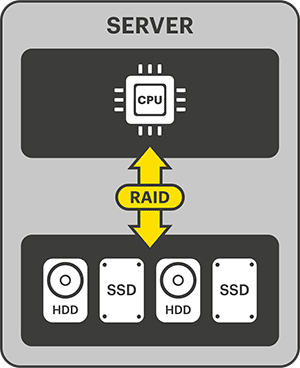 Virtual RAID is a form of RAID where the protection comes from the CPU chip or the motherboard in the server, instead of a dedicated RAID controller plug-in PCI board. This is an inexpensive and practical solution, allowing organizations to purchase server hardware that already contains RAID protection without any need for additional hardware or software to purchase or maintain. The most common solution in this space has come from Intel and its VROC (Virtual RAID on CPU) product.
Virtual RAID is a form of RAID where the protection comes from the CPU chip or the motherboard in the server, instead of a dedicated RAID controller plug-in PCI board. This is an inexpensive and practical solution, allowing organizations to purchase server hardware that already contains RAID protection without any need for additional hardware or software to purchase or maintain. The most common solution in this space has come from Intel and its VROC (Virtual RAID on CPU) product.
Intel VROC is a type of virtual RAID available on Intel Xeon Scalable CPUs and therefore eliminates the complexity, cost, and power consumption of traditional hardware RAID cards. As a result, VROC is an excellent solution to provide RAID protection at edge locations. Providing the servers deployed contain the correct Xeon CPUs, then VROC can be enabled to protect critical data.
Hardware RAID
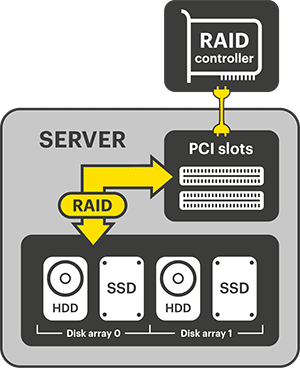
A hardware RAID controller is a physical component, sometimes known as a RAID card, and is inserted into a PCI slot in a server. This is a very common way of achieving RAID data protection, and there are many vendors producing such hardware. It also offers the greatest number of RAID levels.
Hardware RAID controllers can help improve performance, since the processing is handled by the RAID card instead of the server CPU or OS. The hardware RAID card can work effectively in larger servers as well as on a desktop computer. Writing backups and restoring data will produce less strain when using the hardware RAID card. In addition, hardware-based RAID systems will be quicker than software-based systems when rebuilding the mirrored RAID data because they typically have some type of processor included to offload the server’s CPU.
Based on the hardware system, the RAID subsystem can be managed independently of the host and even though there are typically many physical disk drives, only one single disk volume is provided for the host per RAID array. For example, a hardware RAID device can connect to a SCSI controller and present the RAID array as a single SCSI drive.
However, while it is a common solution, the consumption of PCI slots, the cost of acquiring additional components and the need to run proprietary software to ensure the hardware RAID controller is compatible with the server operating system all contribute toward making hardware RAID a somewhat cumbersome solution.
Software RAID
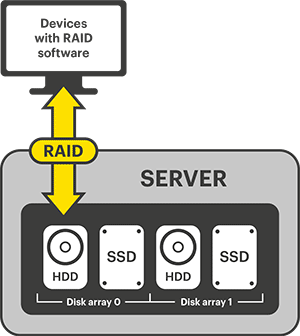 When storage drives are connected directly to the server’s motherboard without a RAID controller, the RAID configuration is managed by the utility software in the operating system. This process is referred to as the software RAID setup.
When storage drives are connected directly to the server’s motherboard without a RAID controller, the RAID configuration is managed by the utility software in the operating system. This process is referred to as the software RAID setup.
Software RAID is a much more economical choice compared with a hardware RAID controller, as it is often included free in many operating systems.
Software-based RAID systems can usually perform adequately for 3 basic RAID levels: RAID 0, RAID 1, and RAID 10. However, when using more complex RAID levels, software-based RAID programs may impact the performance of the RAID system and of the server.
With a software-based RAID controller, one or more CPU cores, as well as RAM could impact other processes that are running on the computer. The extent of the software RAID controller’s impact depends on the RAID level in use and the number of drives that makes up the RAID array.
Which RAID solution is best suited for edge computing environments?
Implementing RAID for data protection at edge locations depends heavily on the IT infrastructure and resource available onsite. For instance, while hardware RAID cards are a common way of introducing RAID protection, they require available PCI slots on the servers being used, as well as the additional purchase, installation and maintenance of these components.
Combined, these factors do not lend themselves well to the edge, where conditions can be remote, with limited space and resource available. Because of these limitations, organizations may well choose to deploy hardware designed for the edge. Servers in this category tend to be small and ruggedized, such as HPE’s Edgeline range, or Lenovo’s SE350/SE450. These server ranges have very limited, if any, hardware RAID card support.
In these circumstances, organizations will turn to virtual RAID or software RAID as a method to protect data. Yet in the case of virtual RAID, this could also be problematic at the edge as it requires the servers being used to contain the correct, compatible CPUs. If the servers aren’t compatible, then virtual RAID also becomes impossible. Software RAID consequently becomes the most viable option to ensure data is protected through RAID at the edge. There are numerous software RAID solutions available on the market, allowing organizations to configure their infrastructure in the best manner for their individual use case. This flexibility is key for the variances of edge computing environments.
Software RAID with StorMagic SvSAN
StorMagic is one of the leading pioneers of edge computing solutions and SvSAN, our virtual SAN, supports software RAID 0, RAID 1 and RAID 10. This delivers RAID protection for organizations who do not wish to, or simply cannot, use hardware RAID and enables the use of any small form factor edge server that doesn’t have a built-in RAID card.
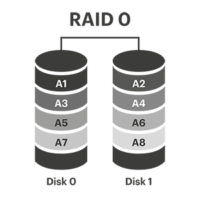 The fastest version of RAID, RAID 0 is easy to implement, is supported by all hardware controllers, and is recommended for non-critical storage and requires high-speed reads and writes. Also referred to as disk striping, RAID 0 divides up a chunk of data into blocks, and spreads those blocks across a number of storage devices like SSDs or hard disks in a RAID group. As it lacks redundancy however, it isn’t recommended for mission-critical storage, so is best paired with RAID 1.
The fastest version of RAID, RAID 0 is easy to implement, is supported by all hardware controllers, and is recommended for non-critical storage and requires high-speed reads and writes. Also referred to as disk striping, RAID 0 divides up a chunk of data into blocks, and spreads those blocks across a number of storage devices like SSDs or hard disks in a RAID group. As it lacks redundancy however, it isn’t recommended for mission-critical storage, so is best paired with RAID 1.
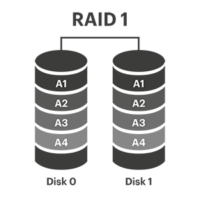 Deemed to be the most reliable version of RAID, RAID 1 refers to the replication of data to two or more disk drives. Also known as disk mirroring, it is well adapted to harsh edge environments due to its ability to support applications that require high availability, and high performance.
Deemed to be the most reliable version of RAID, RAID 1 refers to the replication of data to two or more disk drives. Also known as disk mirroring, it is well adapted to harsh edge environments due to its ability to support applications that require high availability, and high performance.
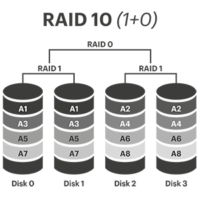 RAID 10 takes the best of both RAID 0 and RAID 1, combining the striping of RAID 0 with the mirroring of RAID 1 to protect data. Capable of writing two disks at once, it’s able to speed up both read and write operations, and is well suited to frequently-used, mission-critical database servers. With no reliance on parity to rebuild a volume once a disk fails, RAID 10 provides complete redundancy, and creates little to no downtime.
RAID 10 takes the best of both RAID 0 and RAID 1, combining the striping of RAID 0 with the mirroring of RAID 1 to protect data. Capable of writing two disks at once, it’s able to speed up both read and write operations, and is well suited to frequently-used, mission-critical database servers. With no reliance on parity to rebuild a volume once a disk fails, RAID 10 provides complete redundancy, and creates little to no downtime.
Software RAID 0, 1 and 10 options come as standard with SvSAN licenses, making it both a reliable and cost-effective option for SMEs and organizations operating at the edge. To learn more about SvSAN’s software RAID feature and how it can sit within a wider data protection strategy at the edge, download the infographic and watch our recorded webinar titled: “The Future of Data Protection at the Edge”.

